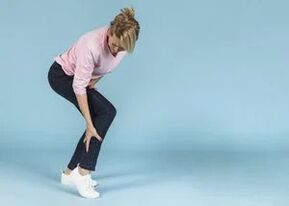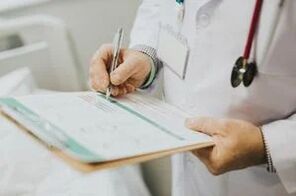The angiosurgeons argue that varicose veins are a process such pathological, following which the venous wall changes with a deficiency in a subsequent valve.
Reasons
The exact causes of varicose veins are not yet known.Based on epidemiological studies, it has been found that a genetic predisposition affects the pathological process.

The predisposing factors are also known, from which varicose veins may appear:
- violation of the hormonal context (menopause, contribution of estrogens);
- overweight;
- pregnancy;
- long static loads;
- wear tight linen;
- constipation;
- Surgical intervention (arteriovenous bridging);
- Development defects or obstruction of deep veins.
What does it look like?
Since varicose veins are a modification of the veins, pathology is classified not only to vascular diseases, but also to cosmetic problems:
- Patients first notice the occurrence of a venous scheme on the legs or the appearance of net veins.
- Later, the veins become convincing, lift the skin.
- In large -scale stages, the varicose nodes are clearly visible, representing the confusion and expansion of the venous vessels.
The violation of tissue trophism leads to a change of skin pigmentation.
Steps (degree)
Several stages, or degrees, varicose veins are distinguished.With varicose veins of the 1st degree in patients, heavy legs of So-appeal is diagnosed.Often, patients complain of cramps in the calf and swelling muscles, which disappears after rest.
With varicose veins of the 2nd degree, persistent edema occurs, altered skin pigmentation, stagnant dermatitis.In advanced cases, trophic ulcers appear in the 3rd degree of disease.
Prevention value
Knowing the predisposing factors of the occurrence of the disease, attention must be given to the prevention of varicose veins:
- Wear comfortable shoes and underwear;
- Minimization of work associated with static loads and a prolonged standing position on the legs;
- physical education lessons;
- Reception of vitamins: C, E, PP;
- Power correction.
If there is no way to change the work which is the cause of the occurrence of the disease, it is recommended to unload gymnastics during the day and the massage of drainage in the evening.Wearing elastic bandages and a contrast shower will help avoid the disease.
Signs
The symptoms of varicose veins are diversified.The clinical picture depends on the course of the disease and the location of the Varic process.
Leg varicosis
The initial signs of varicose veins are:
- severity in the legs;
- Stress in the legs;
- fatigue while walking;
- Pastinity in the ankle joint (often in the evening);
- convulsions;
- Pain during the enlarged veins.
In women, symptoms develop before menstruation.After rest, the unpleasant sensations in the legs disappear.
Lymphatic deficiency in varicose veins leads to the development of cellulite, dermatosclerosis, trophic ulcers and erysiples.With serious violations of the venous flow, patients complain of itching skin and dry skin in the affected vein area.
Little by little, instead of violation of tissue trophism, the skin is thinner and atrophic.Hyper or hypopigmentation develops.With the progression of the pathological process, cyanotic spots and trophic ulcers appear.

In a pronounced process, patients have complaints concerning:
- increased fatigue;
- pulsation;
- shortness of breath.
These signs are associated with increased load on heart muscle in relation to blood deposit in the venous line.
Reticular varicose veins of the lower limbs
A special manifestation of varicose veins is reticular varicose veins.Clinical manifestations of pathology:
- Increase in local temperature in the ankle joint;
- fatigue and heaviness of the legs;
- Dense subcutaneous tissue.
Varices of esophagus
With an expansion of the veins of esophagus, conviction and bags of blood vessels appear.The main cause of the development of the disease is portal hypertension.
The disease is manifested by the following signs:
- inflammation of the esophagus;
- burning, blunt;
- anemia;
- Difficulty swallowing food.
A dangerous complication of pathology is a massive bleeding of the veins.The patient vomits with blood, hypotension, tachycardia, altered consciousness.
Varicosis of the uterus
The forms of internal varicose veins include varicose veins of the uterus.The main reasons for the change of veins:
- physical activity;
- chronic constipation;
- pregnancy;
- Take hormonal contraceptives;
- development anomalies;
- Abortion.
Women with uterine varicose veins complain of pain at the bottom of the abdomen, violation of the menstrual cycle.The disease can lead to infertility.
Varices of lips
This type of varicose veins in pregnant women can develop from the second month of pregnancy.The disease develops if there was pelvic thrombosis or if there are congenital angioisplasias.
What the varicose veins look like:
- widen vulva veins;
- Comb on the skin following itching;
- swelling.
The disease is accompanied by dysurical disorders, radiant in the perineum.Danger is the development of acute thrombophlebititis, a breakdown of a damaged ship.
Varices of a small pool
The first signs of varicose veins make pain at the bottom of the abdomen.There are several options for the course of this form of the disease:
- Varices and vulva;
- Pelvic venous plethora.
Clinical manifestations of pathology are observed in 30% of women during pregnancy.Disease is a purely feminine pathology.
The venous plethora manifests itself in the following signs:
- severity and pain;
- pain during sex;
- dysmenorrhea;
- Micual disorder.
Varicocele
Varicosis of the seed cord in men is called varicocele.The disease leads to a violation of the venous flow of the testicles.Patients complain of shooting pain in scrotum, erectile dysfunction.When examining the testicles, the enlarged surface veins, the asymmetry of the scrotum is visible.The reasons for the development of the disease include:
- physical activity;
- Congenital deficiency in connective tissue;
- Tumors in the retroperitoneal space or the basin.
With the progression of pathology, spermatogenesis is disturbed, which leads to infertility.The disease can be complicated by the bleeding of the affected vessels.
Varicus dermatitis
In addition to the clinical symptoms characteristic of progressive varicose veins, its complication should be noted - Stagnant dermatitis.In patients, the skin on affected veins begins to become thinner and itching.In inflammation places, dark or light and coat stains appear.
The location of venous dermatitis is the bottom of the leg and the ankle articulation. With combs, the pathological process applies to healthy tissues.If the problem is ignored, inflammation goes to a varicose eczema.
Varicose eczema
Inflammation is obstinate with periods of remission and relapse.Skin lesions are seriously treated even after humans.Due to a violation of microcirculation, the liquid part of the blood is infiltrated through the walls of the affected vessels.In the area above the varicose vein, swelling areas and crying appear.
Bubbles filled with serous or serery content occur on the legs.With combs, an infection enters injuries.Fusion, small bubbles form papules.After opening the vesicles, the crusts appear.The healing site is lightened and covered with scales.During the exacerbation period, vesicles occur again.The progression of pathology leads to the formation of trophic ulcers.
Pain as a sign of the disease

Often, patients complain about pain for varicose veins, which is improved by the palpation of the affected ship.In the initial stages, the sign manifests slightly.A person feels weakness and pulls the pain at the end of the day.In the morning, after rest, the symptoms disappear.In late stages, pain syndrome occurs at night.
A combination of pain and crises at night or after a prolonged position on the legs is considered a classic manifestation of varicose veins.
Location characteristic of pain for varicose veins:
- Air region;
- Tarthful ulcer area;
- The calf muscle.
If an increase in total temperature joins, this may indicate the start of the inflammatory process in Vienna - Thrombophlebititis.
Vascular stars
The vascular stars are called telangioctasia.Pathology is manifested by the expansion of small subcutaneous vessels.On the skin manifests itself in the form of a net of purple or red ships.The causes of telangiectasia can not only be a venous deficiency, but also:
- Connective tissue diseases;
- pathologies of the hepatobiliary system;
- use of hormonal drugs;
- Endocrine diseases.
The vascular mesh manifests on the legs, face or buttocks.Telegioectasis is not a separate disease, but acts as a symptom, representing more cosmetic defect.
On the face
On the face, the appearance of a hair mesh is called rosacea.It appears in the event of violation of the rheological properties of blood, with high blood pressure or diseases of the digestive system, the negative effects of low temperatures or during alcohol consumption.
In women, the main cause of telangiectasis is hormonal restructuring.The gold stallion to eliminate the defect is laser coagulation.
On the feet
On the legs, the vascular mesh appears following venous stagnation.Violet nets often accompany varicose veins.As telangiectasia diseases progress, increase.Even after the elimination of the veins, the hair mesh remains.Elimination methods are scleroderma, radiofrequency removal, endovasal laser coagulation.
How to get rid of?
Before getting rid of varicose veins, they are made by complete diagnoses.Patients have blood and urinary laboratory methods, detection of reflux for subcutaneous veins, functional samples.Among the instrumental techniques, they are assigned:
- Duplex or triplex ultrasound;
- Phlébography of the X-Ray contract;
- Maglebography by magnetic resonance;
- Multi -point computer angiography with contrast.
After determining the degree of varicose veins, the question of the application of treatment methods - surgery or conservative therapy.
Who treats?
If the first symptoms occur, you should contact the clinic of a phlebologist or an angiosurgeon. In district medical facilities, surgeons are engaged in this disease.It should be understood that the experience and qualifications of those who deal with varicose veins play a decisive role in eliminating the problem.Therefore, it is best to contact specialized centers.
What treatment is necessary?
With damage to ships in the lower limbs, the following main methods are used:
- surgery;
- sclerosing therapy;
- Conservative treatment.

In advanced cases, the methods are combined.In chronic venous insufficiency with damage to the valve device of blood vessels and signs of thrombophlebitis, the elimination of the veins (phleectomy) is indicated.Surgical intervention methods with the minimum invasion nature include:
- Thermal removal of the veins: radiofrequency, laser, microwave, steam;
- Non -deserves removal: chemicals with sclerotizing and mechanochemical drugs.
In order to reduce the symptoms of the disease, systemic treatment is prescribed by drugs.Patients are prescribed:
- Antibiotics in Inflammatory Processs and Trophic Ulcer;
- antiseptics;
- phléboprotectors;
- tissue repair stimulants;
- anticoagulants;
- topical steroids with trophic ulcers;
- Local use of heparin drugs.
The condition for the effective elimination of varicose veins is compression treatment using elastic bandages, golf courses, tights.A popular bandage method is a zinc-wewatine bandage for trophic disorders.
What helps better?
Preparations and compression bandages (knitting) are only prescribed by a doctor, taking into account the stage of the disease, its complications, accompanying pathologies and the age of the patient.Therefore, what helps better with varicose veins, a phebologist should say.
It should be understood that treatment only with drugs will not eliminate pathology, as well as wearing compression knitting.
The varicose veins in most cases are only eliminated surgically in combination with other therapy methods.
How to eliminate itching?
To get rid of itching with varicose veins, you should know how to delete it.Doctors prescribe moisturizing therapeutic ointments (you can use children's cream).With serious itching and peeling of the skin, drugs with hormones are prescribed.
They use compresses with decorations of herbs with an anti-inflammatory effect (chamomile, calendula, sage, series, hop cones).
What is dangerous?
The consequences of varicose veins include phlebitis, trophic ulcers, thrombophlebitis, menstrual violation, erectile dysfunction, infertility.The formation of a thrombus and bleeding of the affected vessels is that varicose veins are dangerous.
The tissue tissue torn from the lower limbs of a second fall in a small circle of blood circulation, causing a thromboembolism of the pulmonary artery.
With bleeding without emergency medical care, a person loses a lot of blood.All these complications lead to a handicap or death without adequate treatment.
Conclusions
Varicosis refers to a common pathology.It develops in people with a hereditary predisposition with excessive static and dynamic loads, as well as with their prolonged absence.
The disease leads to serious complications, so if the first signs occur, it is necessary to contact a phebologist.
You can only get rid of the problem with an integrated approach.
Patients have surgical treatment methods, drugs, wearing compression knitting and lifestyle correction.
